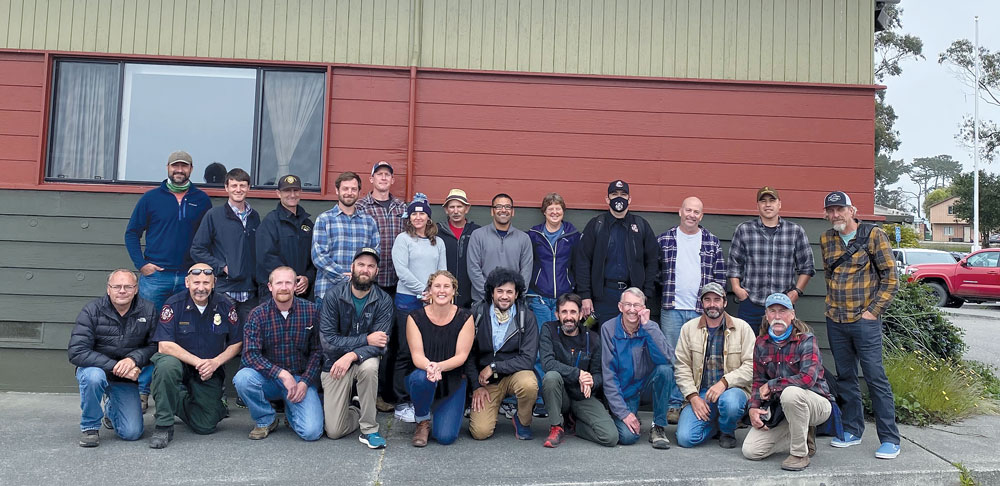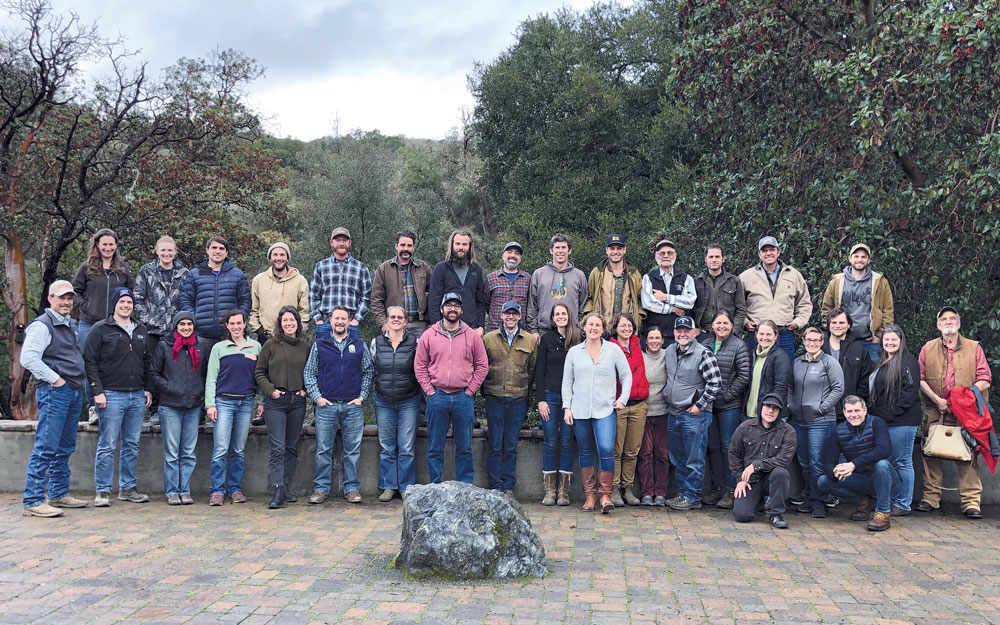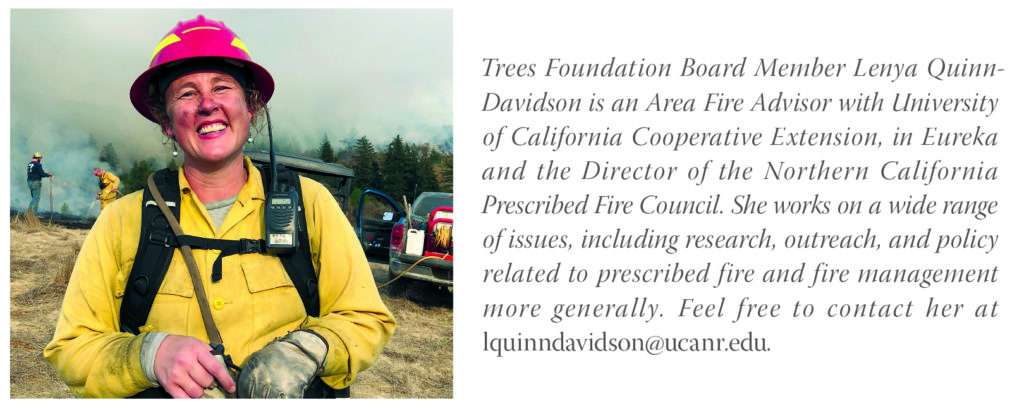Living With Fire
California’s Prescribed Fire Movement: A Decade of Inspirational Change

By Lenya Quinn-Davidson, Area Fire Advisor, University of California Cooperative Extension, and Director, Northern California Prescribed Fire Council
The following was transcribed from a presentation given on May 11, 2021, as part of the Western Klamath Restoration Partnership Fire Workshop. It has been edited for length.
I was asked to talk a little bit today about some of the neat stuff that’s going on around the state related to Prescribed Burn Associations and cooperative burning, and I decided to call the talk “California’s Prescribed Fire Movement” because I really see that as what this is. This is a grassroots movement that has just spread like crazy all over the state, and people are empowered and excited and leading in ways that we haven’t seen until now.
I think it’s such an exciting time for prescribed fire, especially within the private sector and with cultural burning and all of these local community-based efforts that are just kicking ass all over California. So I plan to talk about that, and that will segue well into what Margo [Robbins] will share, which is a little bit of a deeper dive into the work that she’s doing there in the Mid Klamath.
So I wanted to start by sharing a timeline I put together today, which I’m calling “A Decade of Inspirational Change”…it shows how far we’ve come, just in the last decade in California. I put this funny picture of Morgan Varner on the left. I was thinking recently about that first Klamath Fire Ecology Symposium where Morgan gave that great talk about fear versus hope, which he titled “Lessons from a frequent fire landscape” in Florida, and how we were doing everything wrong here in California, which [laugh] at that time was true.
At that time, you in the Mid Klamath were some of the only people really leading on this local prescribed-fire work. And in 2009, we formed the Northern California Prescribed Fire Council, from some of the conversations that came out of that first Klamath Fire Ecology Symposium. And in 2013, we hosted California’s very first TREX [Prescribed Fire Training Exchange] event, and then here we are in 2021, and across the state, there have been 32 different TREX events, and we have about 13 different Prescribed Burn Associations that have formed just in the last couple of years….
So I think one of the big questions that’s come up in this decade of inspiration has really been about who has access to fire. [Who has access to] fire decision-making, to using fire, to being involved in the discussion and the discourse around fire? And really, the question is whether fire users need to be fire professionals. Does everyone who’s using prescribed fire need to be someone who also works in fire suppression?
I think for a long time in the Western US, that has been the status quo—that if you wanted to be involved in prescribed fire, you had to be working for a fire management agency that was actively involved in fire suppression. I think we’re really questioning that now, and we’re changing that conversation, and we’re saying no, fire users don’t need to be fire professionals. Fire users are stewards, they’re local community leaders, they’re landowners, they’re cultural practitioners, and they’re the people who are connected to place and to the land. So we’re opening that up and really making it a more inclusive conversation, and empowering a different future around prescribed fire.
Prescribed Burn Association Philosophy
I wanted to share some of the core philosophies of this Prescribed Burn Association model, which we in California…have borrowed and adapted from the model in the Great Plains, of all places. I’m sure many of you have heard me talk about going out to Nebraska and learning about Prescribed Burn Associations, and then bringing that back to Humboldt County and California. But there are some philosophies there behind that model that I just think are so powerful. The very first one is that idea of inclusivity, that everyone’s welcome, and that people—any kind of person—has something to bring to the table when it comes to prescribed fire. It doesn’t all have to be operational, it can be different skills. We have a lot of different skills that we employ when we plan burns, or when we implement them. There should be a spot for anyone who wants to be involved, and every burn is a training burn. I feel like our work on Prescribed Burn Associations in California has really been inspired by TREX, by the idea that everyone’s both a student and a teacher, and that there’s always something more to learn…That idea of cooperation and collaboration and training is really key to all of this.
Now, I think the next one is really important. Prescribed fire does not have to be expensive or bureaucratic. It is a fundamental tool that people have been using forever, and it still is, and we shouldn’t always just be chasing money or getting bogged down in permits and bureaucracy. At the end of the day, we can go out and use fire, and it’s a beautiful, simple tool that costs nothing. So if you have communities working together, and people willing to volunteer and show leadership, prescribed fire is not expensive, and sometimes it’s actually just totally free. So we need to remember that: don’t default to thinking that you need money for this.
I think it’s really important to remember that fire is a land management tool, it’s not just a fire management tool. And this is something that came up for me when I was spending some time in Florida burning. I really noticed that the culture there on prescribed fire is that anyone who’s a land manager is using prescribed fire. It’s not just something that the fire management agencies are using. It’s just a core stewardship tool such that anyone who’s managing a piece of ground is going to have fire in their tool box. So [we’re] really trying to bring that notion back here to California.
PBAs Spreading across California
I want to share some of these amazing groups that have formed around the state in the last few years. There are a lot of groups that are actually calling themselves Prescribed Burn Associations or PBAS. We have the one in Humboldt, we have one in Mendocino, there’s Siskiyou, the Central Coast just formed one. We’re seeing a lot of these PBAs popping up all over the place. But we’re also seeing groups that are calling themselves something different, even though they really are in essence a Prescribed Burn Association or a community cooperative. We’ve got the Good Fire Alliance down in the North Bay (Sonoma and Marin counties); Sasha Berleman, whom I’m sure many of you know, is with Audubon Canyon Ranch and they’ve taken the lead on the Good Fire Alliance. It’s a group of a lot of NGO folks and community members and landowners who are getting together and burning together and doing a lot of really awesome work down there, not in an easy location either.

There are also Range Improvement Associations, which were really the early concept behind Prescribed Burn Associations. There are groups down in the South Central Coast (Santa Barbara and San Luis Obispo) that are led by the ranching community and formed in the early to mid-1900s, and then had a long period where they were stagnant and weren’t really doing much, and have now been reinvigorated because of all this movement around Prescribed Burn Associations. So it’s been pretty neat to see that, and they have a very specific focus and kind of just a different vibe than some of the other groups up here, but really interesting.
There are also some other groups on the east side. The Plumas Underground Cooperative is another PBA that’s up in Plumas County, and they’re unique because they’re burning mostly in timber, they have a lot of forest units, some added complexity there, and they’re using the Cal-TREX events to build capacity, skills, and confidence among their PBA members. So it’s been neat to watch them because they’re taking a little bit of a different approach.
Then there’s a group down in the southern Sierra, the Sierra Sequoia Burn Cooperative, which is really focused on cultural burning and tribal engagement and on the ancestral territory of some of the groups they’re working with. It’s a broad, large region, I think four different counties are involved in this group.
Then of course there are some of these longer standing efforts that aren’t really Prescribed Burn Associations but have been an inspiration for more than a decade in some cases. We’ll hear from Margo [Robbins] on the Cultural Fire Management Council—some of the Karuk family-based burning that’s going on out there is super inspiring. Of course [also inspiring are] the Klamath TREX and the Trinity Integrated Fire Management Partnership with The Watershed Center in Hayfork, and all the cool work that Don Hankins is doing. I think these are all just points of light, and we’re all working together to change the whole conversation around prescribed fire in California.
A couple of years ago, we hosted an event to bring all the leaders of these different groups together. We all convened in Hopland…and spent two or three days talking about laws and regulations and liability, and insurance and PBA formation, and all the kinds of nuts and bolts of how we were going to get these things off the ground in all of our different places. We’ve continued to connect the different leaders. We have an online space where we’re all sharing and talking, and we’ve hosted some events, and…webinars, just to keep building the conversation and the capacity of all these different people. A lot of these folks are new to prescribed fire in some ways, but they have some organizational support or just some passion and interest to lead. So we’ve been trying to create as many opportunities as we can to bring those folks together.
We also developed a website that’s more of a public interface but also useful for folks who are trying to start a Prescribed Burn Association, so I recommend checking that out. It lists all the different groups that have formed around California and kind of helps you tie in and connect with those groups if you’re interested. You can find it at www.calpba.org.
Burn Boss Program
Now, another piece that I wanted to bring up that isn’t directly related to these Prescribed Burn Associations, but could contribute in some really meaningful ways, is this new California State Certified Burn Boss program. It was mandated by Senate Bill 1260 in 2018, and it has been in an ongoing curriculum development and approval process since then. It just finally got fully approved and finalized this Spring. And as I speak, I am hosting the inaugural course of this class here in my office in Eureka.
So this week, I have 19 people here from across the state, all really experienced prescribed fire practitioners, a lot of old friends. It’s a class that’s covering burn planning, smoke management, laws and regulations, a bunch of different elements like that. These folks will be certified as burn bosses and able to bring that certification home with them to build capacity and do more good work on their home landscapes.
What’s the benefit of the certification? I think that’s an important question, and we’re still kind of uncovering that…we’re learning as we go. But according to the legislation that mandated the program, these state-certified burn bosses will have the opportunity to share liability with Cal Fire on specific projects through a cooperative agreement process. It remains to be seen what that process will look like. It doesn’t change the liability standard, but we are working on that [laugh] and I’ll talk about that during the policy section.
I also think one of the big benefits of the state certification will be recognition by NRCS (National Resources Conservation Service). Currently in California, NRCS will only work with federally qualified burn bosses, so you need that RXB2 qualification in order to write burn plans or to lead burns that are funded by NRCS. That’s a huge bottleneck for those of us who are trying to implement on the ground, because there aren’t very many private burn bosses who are willing to do this work for hire, or who are insured to do this work for hire.
So now with the state certification, NRCS has been doing some revisions to their state policy, thankfully. They are going to include the state certification in that revised policy, so that’s a big deal. I think it will really open up a lot more opportunity for us locally.
Then there are some things in the works to deal with the insurance issue for prescribed fire burn bosses. Nothing’s resolved yet, but there’s potential that there could be some kind of state-backed Claims Fund for prescribed fire, and if that were to happen, this certification would probably be recognized in that, so I see that as another benefit if and when we’re able to create those insurance solutions.
I just wanted to finish by…letting you ponder…how much has changed in the last 10 years. I mean, when we formed the Prescribed Fire Council in 2009, no one was used to sitting in a room and talking about prescribed fire with other people. People were very siloed. It was not a conversation that was happening, and now it’s all we can talk about. So I think it’s important to reflect on this decade of amazing stuff that’s happened and to thank all of you for being leaders in that. So with that, I will conclude; feel free to email me if you want any more information or want to become more involved in any of this. Thank you so much.

